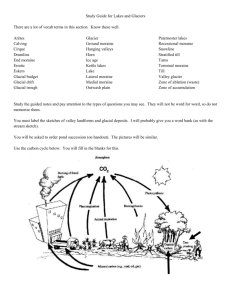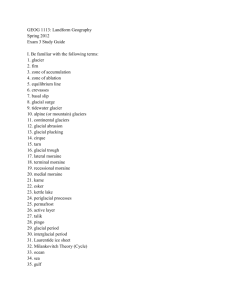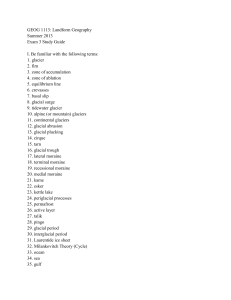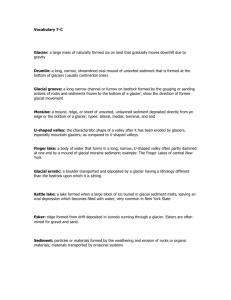Glaciation lesson 6 - Features of Deposition 2
advertisement
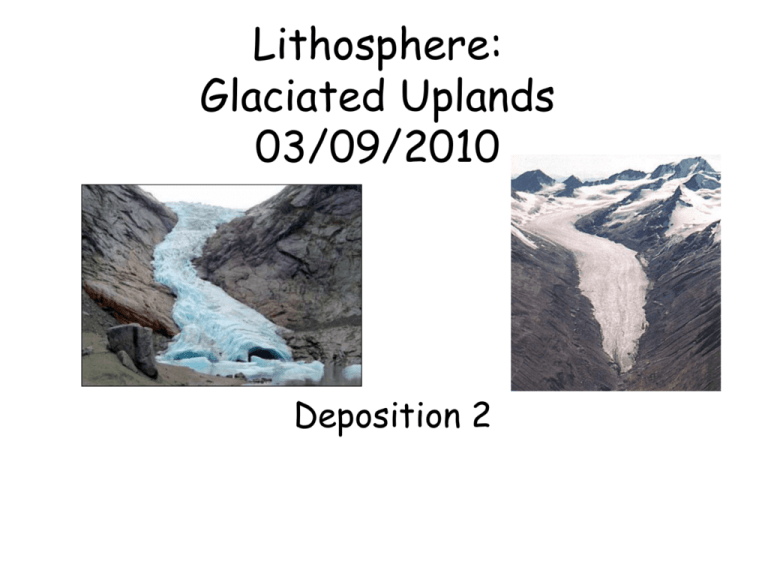
Lithosphere: Glaciated Uplands 03/09/2010 Deposition 2 Drumlins • Description: Oval hills made mostly of till (ground moraine). May be 100 metres to several kilometres long, and up to 100 metres high. Have a rounded stoss side and a tapering lee side (the opposite of roche moutonnées). Often occur in groups called swarms known as basket of eggs topography. • Explanation: Most probably caused by an advancing glacier reshaping existing ground moraine into a streamlined hill, often with a large rock outcrop at its heart. Scottish examples from the Pentland Hills, south of Edinburgh …and from Canada …and from Wisconsin, USA, the best examples of all. FLUVIOGLACIAL DEPOSITS These deposits are different from till (glacial deposits) because the material is sorted and layered. Heaviest material is deposited 1st The material is also more rounded and comprises of mainly sand and gravels. Eskers • Description: Long, sinuous (twisting) ridges of mostly sand and gravel. An esker is a fluvio-glacial deposit. May be several kilometres long and up to 100 metres high. • Explanation: Eskers are the beds of rivers which once flowed on, in or, most commonly, under a glacier (sub-glacial streams). When the glacier melted, these temporary river beds were left on the surface of the ground, but now without the rivers which formed them. ESKERS Made of sorted sands and gravels Long, narrow and winding Formed during deglaciation when material carried in subglacial streams began to be deposited KAMES Small, mound shaped hillocks Made of sand and gravel Laid down by glacial streams Tend to be found in areas with kettle hole lakes Glacial streams are found under the ice-sheet.They are loaded with debris (sand and gravel) carried by the meltwater. As the ice-sheet retreats, the river deposits its load. An esker is a steep-sided, long, winding ridge, made up of gravel and sand. glacier river flowing under ice depositing sand and gravel OUTWASH PLAIN Gently sloping area of land beyond the terminal morraine Made up of sands and gravels Meltwater transports and deposits material which has been collected and eroded by the glacier KETTLE HOLE LAKES Formed when a large piece of ice breaks off from retreating glacier The ice slowly thaws, if the depression is below the water table a kettle loch forms glacier meltwater sorted sands and gravels spread out to form outwash plain Infertile outwash often covered by bog or forest depression formed whendepression ice melts filled with water to form kettle lake block of ice outwash sand and gravel MOULINS •Holes in glaciers that water flows through. •Connect surface streams to subsurface streams. Sediment deposition forms kames Some glacial meltwater streams carry very little material – others a lot. SUB-GLACIAL STREAMS Deposition in these tunnels forms eskers Inside a glacier, on the bed of a sub-glacial stream; … after the ice A Scottish example, showing the sand and gravel interior. Eskers are often quarried to provide sand and gravel for building. Note the fine, sandy texture of this esker – very different from the unsorted, angular material in moraines. Identify the features shown on the diagram by matching the numbers to the names given. Esker; Terminal Moraine; Till (Ground Moraine/Boulder Clay); Outwash Plain; Drumlin; Kettle; Outwash Sands and Gravels. 1 is a Terminal Moraine. A hummocky ridge of unsorted stones, boulders and clays dumped by the glacier at the furthest point it reached 2 is a Drumlin. A long, rounded mound of till, moulded under the flowing ice. Its narrower end points in the direction that the ice was moving. They usually occur in groups (swarms) 3 is a Kettle. A water filled hollow left when a block of ice in the till or outwash melted to leave a hollow 4 is an Esker. A long, winding ridge of sands and gravels left by a stream which ran in an ice tunnel under the melting glacier 5 is Till (Ground Moraine or Boulder Clay). A mixture of broken rocks and clay plastered over the bedrock under the base of the glacier 6 is an Outwash Plain. A nearly flat expanse of sorted sands and gravels washed out of the glacier and carried beyond the terminal moraine 7 is Outwash sands and gravels. The meltwaters washed these away from the glacier, rounding off angular stones and depositing them in layers. Glacial deposition = unsorted deposits = boulder clay fluvioglacial deposition = sorted deposits = sands and gravels Landforms of glacial erosion Landforms of glacial deposition crag and tail Landforms of fluvioglacial deposition moraine esker erratic kettle drumlin outwash plain ACTIVITIES HUMAN ACTIVITY IN GLACIATED LANDSCAPES Discussion: Land uses? What are the pros and cons of these areas? Read p. 106 108 Think about: Farming Forestry Communications Settlement Industry Leisure and Recreation ACTIVITIES OS MAP AND CAIRNGORM Use the map of Cairngorm on page 92 Work through questions 1 6 on page 142 HOMEWORK: (Wednesday to Wednesday) Choose any 2 features of glacial erosion and with the aid of diagrams explain their formation 5 marks Choose any 2 features of glacial deposition and with the aid of diagrams explain their formation 5 marks Ablation melting and evaporation of glacial ice at its snout Abrasion sand-papering effect that smoothes and polishes rocks Alluvial fan fan shaped deposit of silt when a river flows on to a plain Alpine glacier valley glacier Arête sharp, knife-edged ridge between two corries Boulder clay ground moraine Cirque armchair shaped hollow at the head of a glacial valley Continental glacier ice sheet Corrie cirque Corrie lochan tarn Crag & tail steep rock face with a gentle slope of boulder clay Crevasse deep vertical crack formed in ice Cwm cirque Drumlin elongated mound of ground moraine End moraine terminal moraine Erratic rock transported by ice and deposited on a different rock surface Esker winding ridge of sand and gravel Fiord glacial trough drowned by a rise in sea level Firn granular ice Fluvio-glacial formed by meltwater flowing in or off a glacier Freeze-thaw weathering of rock by expansion of water in cracks when it freezes Frost shattering freeze-thaw Glacial deposition sediment left behind when a glacier melts Glacial erosion wearing away of rocks by abrasion and plucking Glacial ice ice formed when snow is compressed Glacial transportation movement of materials by glacial flow Glacial trough glaciated U-shaped valley with steep sides and a flat bottom Glacier mass of ice which flows by gravity Ground moraine material deposited at the base of a glacier Hanging valley valley above the level of the main valley often with a waterfall Headwall steep back wall of a cirque Ice sheet mass of ice not limited to a valley Horn pyramidal peak Kettle small shallow lake on an outwash plain formed by blocks of ice melting. Lateral moraine moraine deposited along the sides of a valley glacier Medial moraine moraine formed when two alpine glaciers flow together Meltwater rivers formed by melting ice Misfit river winding river flowing in a valley it did not form Moraine angular, unsorted waste material transported by a glacier Névé firn Outwash plain sorted deposits of sands and gravels spread by meltwater Plucking erosional process - meltwater freezes into cracks and pulls out loose rock Pyramidal peak sharp, pointed peak formed by glacial action Ribbon lake long, narrow lake in a glacial trough Scree sharp, angular material produced by frost shattering Sea loch fiord Snowfield area of permanent snow found above the snowline Snout end of a glacier Striations scratches on the bedrock made by moraine carried in a glacier Tarn small circular lake in a cirque Terminal moraine moraine ridge deposited at the snout of a glacier Till ground moraine Truncated spur interlocking spur that has been cut-off by glacial erosion U-shaped valley glacial trough Valley glacier glacier confined to a valley




